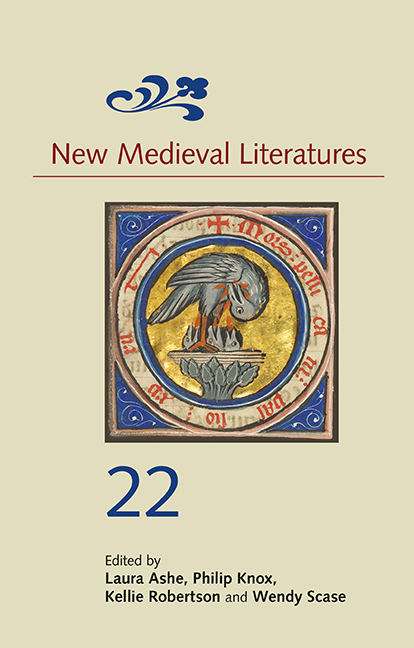Book contents
- Frontmatter
- Contents
- List of Illustrations
- List of Abbreviations
- 1 Touch and Movement in Chrétien de Troyes’s Chevalier de la Charrette
- 2 Cavernous Charisma: The Caves of the Patriarchs at Hebron
- 3 Lawman’s Vision of History: Sources and Figuration in the Brut
- 4 What the Mole Knows: Experience, Exempla, and Interspecies Dialogue in Albert the Great’s De animalibus
- 5 Demonic Prosthesis and the Walking Dead: The Materiality of Chaucer’s Green Yeoman
- 6 Learning to Live in Communities: Household Confession and Medieval Forms of Living
- 7 Alain Chartier’s Quadrilogue invectif and the Poetics of Political Community
- 8 Reginald Pecock’s moral philosophie, and Robert Holcot O.P.: Faith, Probabilism, and ‘Conscience’
- New Medieval Literatures Scholars of Colour Essay Prize
6 - Learning to Live in Communities: Household Confession and Medieval Forms of Living
Published online by Cambridge University Press: 26 May 2022
- Frontmatter
- Contents
- List of Illustrations
- List of Abbreviations
- 1 Touch and Movement in Chrétien de Troyes’s Chevalier de la Charrette
- 2 Cavernous Charisma: The Caves of the Patriarchs at Hebron
- 3 Lawman’s Vision of History: Sources and Figuration in the Brut
- 4 What the Mole Knows: Experience, Exempla, and Interspecies Dialogue in Albert the Great’s De animalibus
- 5 Demonic Prosthesis and the Walking Dead: The Materiality of Chaucer’s Green Yeoman
- 6 Learning to Live in Communities: Household Confession and Medieval Forms of Living
- 7 Alain Chartier’s Quadrilogue invectif and the Poetics of Political Community
- 8 Reginald Pecock’s moral philosophie, and Robert Holcot O.P.: Faith, Probabilism, and ‘Conscience’
- New Medieval Literatures Scholars of Colour Essay Prize
Summary
A, Lord! And in anoþer place þou seist: þou moste forȝeue of al þin herte. O, Lord! It is hard to an erþeli man […] to do þe deedis of mercy
These lines, from St Brendan's Confession – a fourteenth-century confessional form surviving in eight fourteenth-and fifteenth-century manuscripts – describe the difficulty of living a good life in relation to other people. The corollary of this sentiment, both in St Brendan's Confession and in confessional forms in general, is that difficult though it may be, it's nonetheless possible to learn how. As I will argue in this essay, forms of confession – part of a broad genre of literature that may seem, on the face of it, interior and private – made empathetic, ethical, and generous living in communities their central educational aim. Pedagogy underwrites the confessional form, in other words – a pedagogy that, in addition to offering instruction in Christianity's basic tenets, exemplifies how to live among others with generosity and care. Ultimately, this essay will suggest that forms of confession be thought of as forms of living, even as they are also considered to be confessional literature. ‘Form of living’ might seem, on the face of it, so commonplace a term as to obviate explanation, including in its purview instructional texts we have come to call by that name – Richard Rolle's Form of Living and Walter Hilton's Epistle on the Mixed Life spring to mind. Surely, we know a form of living when we see one. And yet, though sometimes this phrase is used in passing – and though its meaning is perhaps taken for granted – it has not in fact been defined explicitly. In his essay ‘Vernacular Books of Religion’, Vincent Gillespie describes several of the texts to be found in Oxford, Bodleian Library, MS Laud Misc. 210, including Book to a Mother and the Charter of the Abbey of the Holy Ghost, as ‘collection[s] of “forms of living.”’ But he does not elaborate further on what might constitute a form of living, and he does not include the confessional form in MS Laud Misc. 210 among the ‘forms of living’ he identifies there.
- Type
- Chapter
- Information
- New Medieval Literatures 22 , pp. 162 - 213Publisher: Boydell & BrewerPrint publication year: 2022
- 1
- Cited by

